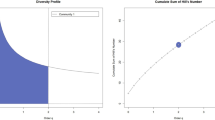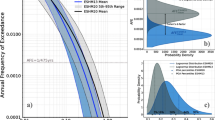Abstract
The task of discriminating between heterogeneity and complete spatial randomness (CSR) for a given point process can be divided into three subtasks: the identification of the point pattern; the determination of the sizes of clusters; and the estimation of the numbers of events in dominant clusters. Many studies have been performed regarding the first and second subtasks. However, limited work has been done on the third aspect; hence, the determination of the number of events in each dominant cluster is still an unsolved problem. In this paper, we provide a solution by constructing a new index which is defined as the ratio between the variance of the (k+1)th nearest distance and that of the kth nearest distance. Our method can be divided into two phases: the detection of point pattern and the estimation of the numbers of events in dominant clusters. These phases can be estimated by the values at which the index abruptly decreases to be less than 1. A comparative study between the existing indices and our index shows the following: (i) our index can indicate the numbers of events in dominant clusters in a relatively objective way, which is different from the K-function revealing the sizes of clustered patterns; (ii) it is a nonparametric index and is easy to implement; and (iii) it demonstrates the highest detection power for differentiating between heterogeneity and CSR. The simulations and two seismic case studies also confirmed the correctness of our method.
Similar content being viewed by others
References
Assunção R (1994) Testing spatial randomness by means of angles. Biometrics 50:531–537
Bailey TC, Gatrell AC (1995) Interactive spatial data analysis. Longman Scientific & Technical, Harlow
Besag JE (1977) Comment on “Modelling spatial patterns” by B.D. Ripley. J R Stat Soc B 39:73–78
Besag JE, Gleaves JT (1973) On the detection of spatial pattern in plant communities. Bull Internat Statist Inst 45(1):153–158
Byth K, Ripley BD (1980) On sampling spatial patterns by distance methods. Biometrics 36:279–284
Byth K (1982) On robust distance-based intensity estimator. Biometrics 38:127–135
Chainey S, Ratcliffe J (2005) GIS and crime mapping. John Wiley & Sons, Inc., New York
China Seismograph Network (CSN) catalog available online at: http://www.csndmc.ac.cn. Accessed in 2010
Clark PJ, Evans FC (1954) Distance to nearest neighbour as a measure of spatial patterns in biological populations. Ecology 35:445–453
Cox TF, Lewis T (1976) A conditional distance ratio method for analyzing spatial patterns. Biometrika 63:483–491
Cressie NAC (1993) Statistics for spatial data. John Wiley & Sons, Inc, New York
Diggle PJ (1977) The detection of random heterogeneity in plant populations. Biometrics 33:390–394
Diggle PJ (1985) A kernel method for smoothing point process data. Appl Stat 34:138–147
Diggle PJ, Gates DJ, Stibbard A (1987) A nonparametric estimator for pairwise-interaction point processes. Biometrika 74:763–770
Douglas JB (1975) Clustering and aggregation. Sankhya, Ser B 37:398–417
Eberhardt LL (1967) Some developments in ‘distance sampling’. Biometrics 23:207–216
Fu ZX, Jiang LX (1997) On large-scale spatial heterogeneties of great shallow earthquakes and plates coupling mechanism in Chinese mainland and its adjacent area. Earthq Res China 13:1–9
Holgate P (1965) Some new tests of randomness. J Ecol 53:261–266
Hopkins B (1954) A new method for determining the type of distribution of plant individuals. Ann Bot 18:213–227
Illian J, Penttinen A, Stoyan H, Stoyan D (2008) Statistical analysis and modelling of spatial point patterns. John Wiley & Sons Ltd, West Sussex
Institute of Geophysics China Earthquake Administration (1989a) The annal of the catalogue of earthquakes in China (1985). Seismological Press, Beijing
Institute of Geophysics China Earthquake Administration (1989b) The annal of the catalogue of earthquakes in China (1986). Seismological Press, Beijing
Institute of Geophysics China Earthquake Administration (1991) The annal of the catalogue of earthquakes in China (1987). Seismological Press, Beijing
Lawson BA (2001) Statistical methods in spatial epidemiology, 1st edn. John Wiley & Sons, New York
Johnson RB, Zimmer WJ (1985) A more powerful test for dispersion using distance measurements. Ecology 6:1669–1675
Liu CR (2001) A comparison of fi distance-based methods for spatial pattern analysis. J Veg Sci 12:411–416
Lloyd M (1967) Mean crowding. J Anim Ecol 36:1–30
Lucio PS, Brito NLC (2004) Detecting randomness in spatial point patterns, a “stat-geometrical” alternative. Math Geol 36:79–99
Meng GK (1996) Discussion on intensity assessments of recent earthquakes in Ningxia. Inland Earthquake 10:330–336
Mugglestone AM, Renshaw E (2001) Spectral tests of randomness for spatial point patters. Environ Ecol Stat 8:237–251
Pei T, Zhu AX, Zhou CH, Li BL, Qin CZ (2007) Delineation of support domain of feature in the presence of noise. Comput Geosci 33:952–965
Pielou EC (1959) The use of point to plant distances in the study of the pattern of plant populations. J Ecol 47:607–613
Pollard JH (1971) On distance-estimator of density in randomly distributed forests. Biometrics 27:991–1002
Prayag VR, Deshmukh SR (2000) Testing randomness of spatial pattern using Eberhardt’s index. Environmetrics 11:571–582
Ripley BD (1976) The second-order analysis of stationary point processes. J Appl Probab 13:255–266
Ripley BD (1977) Modelling spatial patterns. J R Stat Soc B 39:172–192
Schiffers K, Schurr FM, Tielborger K, Urbach C, Moloney K, Jeltsch F (2008) Dealing with virtual aggregation—a new index for analysing heterogeneous point patterns. Ecography 31:545–555
Skellam JG (1952) Studies in statistical ecology, I: spatial pattern. Biometrika 39:346–362
Trifkovic S, Yamamoto H (2008) Indexing of spatial patterns of trees using a mean of angles. J For Res 13:117–121
Thompson HR (1956) Distribution of distance to nth neighbour in a population randomly distributed individuals. Ecology 37:391–394
Zhuang JC, Chang CP, Ogata Y, Chen YL (2005) A study on the background and clustering seismicity in the Taiwan region by using point process models. J Geophys Res Solid Earth 110:B05S18. doi:10.1029/2004JB003157
Author information
Authors and Affiliations
Corresponding author
Rights and permissions
About this article
Cite this article
Pei, T. A Nonparametric Index for Determining the Numbers of Events in Clusters. Math Geosci 43, 345–362 (2011). https://doi.org/10.1007/s11004-011-9325-x
Received:
Accepted:
Published:
Issue Date:
DOI: https://doi.org/10.1007/s11004-011-9325-x




